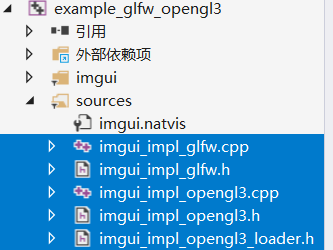【C++】从零开始的CS:GO逆向分析2——配置GLFW+IMGUI环境并创建透明窗口
1.配置glfw
解压后使用Visual Studio打开文件夹
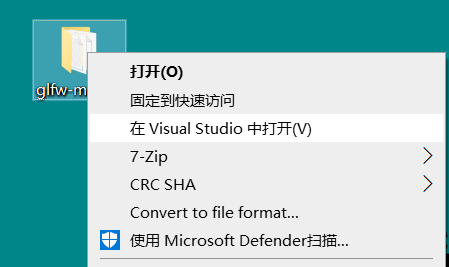

选择全部重新生成,然后选择 安装->glfw
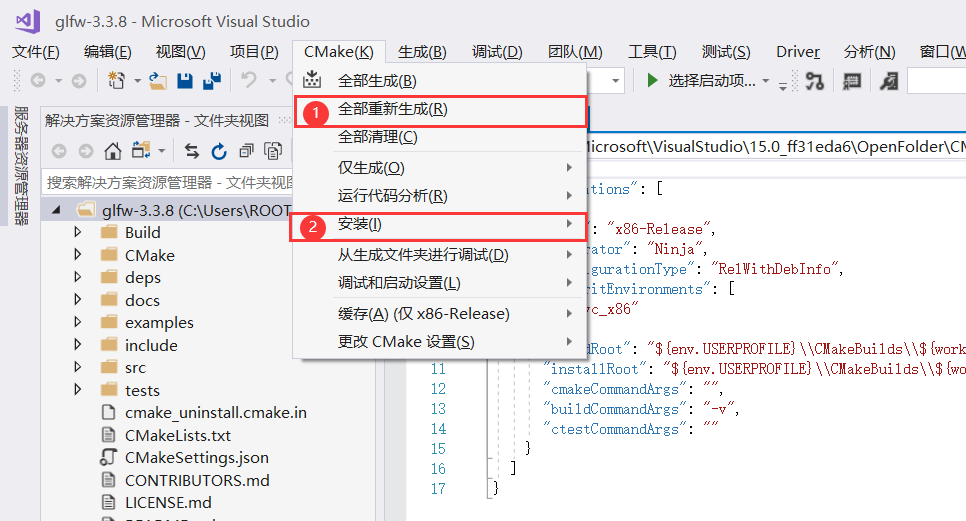
在下面的生成信息可以看到需要的文件生成的位置

打开后,将include、lib文件夹复制到自己的工程文件夹
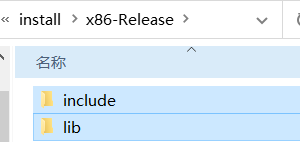
加入后配置自己的工程

项目属性->c/c++ ->常规 下的附加包含目录,输入$(ProjectDir)include 添加
项目属性->链接器->常规 下的附加库目录 ,输入$(ProjectDir)lib 添加
项目属性->链接器->输入 下的附加依赖项 输入 glfw3.lib;opengl32.lib; 添加
配置好后,用代码测试一下
#include <GLFW/glfw3.h>
#pragma comment(lib,"glfw3.lib")
int main(void)
{
GLFWwindow* window; /* Initialize the library */
if (!glfwInit())
return -1; /* Create a windowed mode window and its OpenGL context */
window = glfwCreateWindow(640, 480, "Hello World", NULL, NULL);
if (!window)
{
glfwTerminate();
return -1;
} /* Make the window's context current */
glfwMakeContextCurrent(window); /* Loop until the user closes the window */
while (!glfwWindowShouldClose(window))
{
/* Render here */
glClear(GL_COLOR_BUFFER_BIT); /* Swap front and back buffers */
glfwSwapBuffers(window); /* Poll for and process events */
glfwPollEvents();
} glfwTerminate();
return 0;
}
如果出现一个窗口则说明配置正确,配置有问题的可以检查一下包含的目录 是不是 自己复制到的目录
2.配置IMGUI+glfw
打开glfw下载Binaries
把文件夹里的glew32s.lib复制到自己项目的lib文件夹里
把GL文件夹复制到之前的include文件夹里
在项目属性->链接器->输入 下的附加依赖项 中增加 glew32s.lib;
在项目属性 ->c/c++ ->预处理器 的预处理定义下增加GLEW_STATIC
在实例代码中增加头文件 #include<GL/glew.h>
在
if (!glfwInit())
return -1;
后增加代码
glewInit(); (增加的代码),成功运行则配置成功
下载IMGUI
在自己项目的include文件夹下新建一个imgui文件夹,将imgui-master中以下的文件复制进去
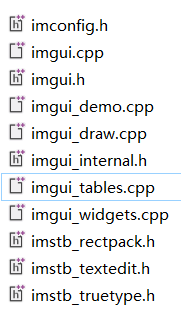
打开imgui的example项目,找到example_glfw_opengl3,在自己项目include文件夹中,创建这五个同名文件,将内容保存进去(其实就是把这几个文件也复制过去)
在自己的项目中新建筛选器(imgui),添加现有项,将include/imgui文件夹里的cpp文件都添加进去
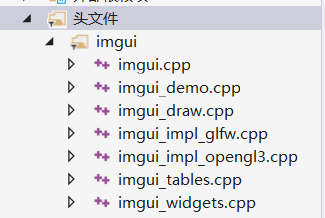
测试代码,如果正常创建则环境正常
// Dear ImGui: standalone example application for GLFW + OpenGL 3, using programmable pipeline
// (GLFW is a cross-platform general purpose library for handling windows, inputs, OpenGL/Vulkan/Metal graphics context creation, etc.)
// If you are new to Dear ImGui, read documentation from the docs/ folder + read the top of imgui.cpp.
// Read online: https://github.com/ocornut/imgui/tree/master/docs #include "imgui/imgui.h"
#include "imgui/imgui_impl_glfw.h"
#include "imgui/imgui_impl_opengl3.h"
#include <stdio.h>
#if defined(IMGUI_IMPL_OPENGL_ES2)
#include <GLES2/gl2.h>
#endif
#include <GLFW/glfw3.h> // Will drag system OpenGL headers // [Win32] Our example includes a copy of glfw3.lib pre-compiled with VS2010 to maximize ease of testing and compatibility with old VS compilers.
// To link with VS2010-era libraries, VS2015+ requires linking with legacy_stdio_definitions.lib, which we do using this pragma.
// Your own project should not be affected, as you are likely to link with a newer binary of GLFW that is adequate for your version of Visual Studio.
#if defined(_MSC_VER) && (_MSC_VER >= 1900) && !defined(IMGUI_DISABLE_WIN32_FUNCTIONS)
#pragma comment(lib, "legacy_stdio_definitions")
#endif static void glfw_error_callback(int error, const char* description)
{
fprintf(stderr, "Glfw Error %d: %s\n", error, description);
} int main(int, char**)
{
// Setup window
glfwSetErrorCallback(glfw_error_callback);
if (!glfwInit())
return 1; // Decide GL+GLSL versions
#if defined(IMGUI_IMPL_OPENGL_ES2)
// GL ES 2.0 + GLSL 100
const char* glsl_version = "#version 100";
glfwWindowHint(GLFW_CONTEXT_VERSION_MAJOR, 2);
glfwWindowHint(GLFW_CONTEXT_VERSION_MINOR, 0);
glfwWindowHint(GLFW_CLIENT_API, GLFW_OPENGL_ES_API);
#elif defined(__APPLE__)
// GL 3.2 + GLSL 150
const char* glsl_version = "#version 150";
glfwWindowHint(GLFW_CONTEXT_VERSION_MAJOR, 3);
glfwWindowHint(GLFW_CONTEXT_VERSION_MINOR, 2);
glfwWindowHint(GLFW_OPENGL_PROFILE, GLFW_OPENGL_CORE_PROFILE); // 3.2+ only
glfwWindowHint(GLFW_OPENGL_FORWARD_COMPAT, GL_TRUE); // Required on Mac
#else
// GL 3.0 + GLSL 130
const char* glsl_version = "#version 130";
glfwWindowHint(GLFW_CONTEXT_VERSION_MAJOR, 3);
glfwWindowHint(GLFW_CONTEXT_VERSION_MINOR, 0);
//glfwWindowHint(GLFW_OPENGL_PROFILE, GLFW_OPENGL_CORE_PROFILE); // 3.2+ only
//glfwWindowHint(GLFW_OPENGL_FORWARD_COMPAT, GL_TRUE); // 3.0+ only
#endif // Create window with graphics context
GLFWwindow* window = glfwCreateWindow(1280, 720, "Dear ImGui GLFW+OpenGL3 example", NULL, NULL);
if (window == NULL)
return 1;
glfwMakeContextCurrent(window);
glfwSwapInterval(1); // Enable vsync // Setup Dear ImGui context
IMGUI_CHECKVERSION();
ImGui::CreateContext();
ImGuiIO& io = ImGui::GetIO(); (void)io;
//io.ConfigFlags |= ImGuiConfigFlags_NavEnableKeyboard; // Enable Keyboard Controls
//io.ConfigFlags |= ImGuiConfigFlags_NavEnableGamepad; // Enable Gamepad Controls // Setup Dear ImGui style
ImGui::StyleColorsDark();
//ImGui::StyleColorsLight(); // Setup Platform/Renderer backends
ImGui_ImplGlfw_InitForOpenGL(window, true);
ImGui_ImplOpenGL3_Init(glsl_version); // Load Fonts
// - If no fonts are loaded, dear imgui will use the default font. You can also load multiple fonts and use ImGui::PushFont()/PopFont() to select them.
// - AddFontFromFileTTF() will return the ImFont* so you can store it if you need to select the font among multiple.
// - If the file cannot be loaded, the function will return NULL. Please handle those errors in your application (e.g. use an assertion, or display an error and quit).
// - The fonts will be rasterized at a given size (w/ oversampling) and stored into a texture when calling ImFontAtlas::Build()/GetTexDataAsXXXX(), which ImGui_ImplXXXX_NewFrame below will call.
// - Read 'docs/FONTS.md' for more instructions and details.
// - Remember that in C/C++ if you want to include a backslash \ in a string literal you need to write a double backslash \\ !
//io.Fonts->AddFontDefault();
//io.Fonts->AddFontFromFileTTF("../../misc/fonts/Roboto-Medium.ttf", 16.0f);
//io.Fonts->AddFontFromFileTTF("../../misc/fonts/Cousine-Regular.ttf", 15.0f);
//io.Fonts->AddFontFromFileTTF("../../misc/fonts/DroidSans.ttf", 16.0f);
//io.Fonts->AddFontFromFileTTF("../../misc/fonts/ProggyTiny.ttf", 10.0f);
//ImFont* font = io.Fonts->AddFontFromFileTTF("c:\\Windows\\Fonts\\ArialUni.ttf", 18.0f, NULL, io.Fonts->GetGlyphRangesJapanese());
//IM_ASSERT(font != NULL); // Our state
bool show_demo_window = true;
bool show_another_window = false;
ImVec4 clear_color = ImVec4(0.45f, 0.55f, 0.60f, 1.00f); // Main loop
while (!glfwWindowShouldClose(window))
{
// Poll and handle events (inputs, window resize, etc.)
// You can read the io.WantCaptureMouse, io.WantCaptureKeyboard flags to tell if dear imgui wants to use your inputs.
// - When io.WantCaptureMouse is true, do not dispatch mouse input data to your main application, or clear/overwrite your copy of the mouse data.
// - When io.WantCaptureKeyboard is true, do not dispatch keyboard input data to your main application, or clear/overwrite your copy of the keyboard data.
// Generally you may always pass all inputs to dear imgui, and hide them from your application based on those two flags.
glfwPollEvents(); // Start the Dear ImGui frame
ImGui_ImplOpenGL3_NewFrame();
ImGui_ImplGlfw_NewFrame();
ImGui::NewFrame(); // 1. Show the big demo window (Most of the sample code is in ImGui::ShowDemoWindow()! You can browse its code to learn more about Dear ImGui!).
if (show_demo_window)
ImGui::ShowDemoWindow(&show_demo_window); // 2. Show a simple window that we create ourselves. We use a Begin/End pair to created a named window.
{
static float f = 0.0f;
static int counter = 0; ImGui::Begin("Hello, world!"); // Create a window called "Hello, world!" and append into it. ImGui::Text("This is some useful text."); // Display some text (you can use a format strings too)
ImGui::Checkbox("Demo Window", &show_demo_window); // Edit bools storing our window open/close state
ImGui::Checkbox("Another Window", &show_another_window); ImGui::SliderFloat("float", &f, 0.0f, 1.0f); // Edit 1 float using a slider from 0.0f to 1.0f
ImGui::ColorEdit3("clear color", (float*)&clear_color); // Edit 3 floats representing a color if (ImGui::Button("Button")) // Buttons return true when clicked (most widgets return true when edited/activated)
counter++;
ImGui::SameLine();
ImGui::Text("counter = %d", counter); ImGui::Text("Application average %.3f ms/frame (%.1f FPS)", 1000.0f / ImGui::GetIO().Framerate, ImGui::GetIO().Framerate);
ImGui::End();
} // 3. Show another simple window.
if (show_another_window)
{
ImGui::Begin("Another Window", &show_another_window); // Pass a pointer to our bool variable (the window will have a closing button that will clear the bool when clicked)
ImGui::Text("Hello from another window!");
if (ImGui::Button("Close Me"))
show_another_window = false;
ImGui::End();
} // Rendering
ImGui::Render();
int display_w, display_h;
glfwGetFramebufferSize(window, &display_w, &display_h);
glViewport(0, 0, display_w, display_h);
glClearColor(clear_color.x * clear_color.w, clear_color.y * clear_color.w, clear_color.z * clear_color.w, clear_color.w);
glClear(GL_COLOR_BUFFER_BIT);
ImGui_ImplOpenGL3_RenderDrawData(ImGui::GetDrawData()); glfwSwapBuffers(window);
} // Cleanup
ImGui_ImplOpenGL3_Shutdown();
ImGui_ImplGlfw_Shutdown();
ImGui::DestroyContext(); glfwDestroyWindow(window);
glfwTerminate(); return 0;
}
至此,环境配置完毕
让鼠标事件透过创建的窗口
glfwWindowHint(GLFW_MOUSE_PASSTHROUGH, GLFW_TRUE);
让窗口透明
glfwWindowHint(GLFW_TRANSPARENT_FRAMEBUFFER, true);
置顶窗口
glfwWindowHint(GLFW_FLOATING, true);
禁止更改窗口大小
glfwWindowHint(GLFW_RESIZABLE, false);
窗口最大化
glfwWindowHint(GLFW_MAXIMIZED, true);
设置没有标题栏
glfwSetWindowAttrib(window, GLFW_DECORATED, false);
删除掉没有用的代码,删掉界面显示的代码,设置窗口透明,设置窗口最大化,设置鼠标通过,设置窗口不允许resize,就可以得到一个透明的窗口,即下面的代码
#include <stdio.h>
#include<Windows.h>
#include <GLFW/glfw3.h>
#include "imgui/imgui.h"
#include "imgui/imgui_impl_glfw.h"
#include "imgui/imgui_impl_opengl3.h"
#include "imgui/alifont.hpp" static void glfw_error_callback(int error, const char* description)
{
fprintf(stderr, "Glfw Error %d: %s\n", error, description);
} int main()
{
glfwSetErrorCallback(glfw_error_callback);
if (!glfwInit())
return 1;
GLFWmonitor *monitor = glfwGetPrimaryMonitor();
//###########################设置窗口###########################
const char* glsl_version = "#version 130";
int Height = glfwGetVideoMode(monitor)->height;
int Width = glfwGetVideoMode(monitor)->width;
glfwWindowHint(GLFW_FLOATING, true);
glfwWindowHint(GLFW_RESIZABLE, false);
glfwWindowHint(GLFW_MAXIMIZED, true);
glfwWindowHint(GLFW_TRANSPARENT_FRAMEBUFFER, true);
glfwWindowHint(GLFW_MOUSE_PASSTHROUGH, GLFW_TRUE); //###########################设置窗口###########################
GLFWwindow* window = glfwCreateWindow(Width, Height, "titile", NULL, NULL);
if (window == NULL)
return 1;
glfwSetWindowAttrib(window, GLFW_DECORATED, false); //设置没有标题栏
ShowWindow(GetConsoleWindow(), SW_HIDE);
glfwMakeContextCurrent(window);
glfwSwapInterval(1);
IMGUI_CHECKVERSION();
ImGui::CreateContext();
ImGuiIO& io = ImGui::GetIO(); (void)io;
ImGui::StyleColorsDark();
ImGui_ImplGlfw_InitForOpenGL(window, true);
ImGui_ImplOpenGL3_Init(glsl_version);
while (!glfwWindowShouldClose(window))
{
glfwPollEvents();
glClear(GL_COLOR_BUFFER_BIT);
ImGui_ImplOpenGL3_NewFrame();
ImGui_ImplGlfw_NewFrame();
ImGui::NewFrame(); ImGui::Render();
int display_w, display_h;
glfwGetFramebufferSize(window, &display_w, &display_h);
glViewport(0, 0, display_w, display_h);
ImGui_ImplOpenGL3_RenderDrawData(ImGui::GetDrawData());
glfwSwapBuffers(window);
} // Cleanup
ImGui_ImplOpenGL3_Shutdown();
ImGui_ImplGlfw_Shutdown();
ImGui::DestroyContext();
glfwDestroyWindow(window);
glfwTerminate(); return 0;
}
至此,已经配置好了glfw+imgui的环境,并且创建了透明窗口,下一章用第一篇里的偏移值做点事
【C++】从零开始的CS:GO逆向分析2——配置GLFW+IMGUI环境并创建透明窗口的更多相关文章
- 【C++】从零开始的CS:GO逆向分析1——寻找偏移与基址的方法
[C++]从零开始的CS:GO逆向分析1--寻找偏移与基址的方法 前言:此文章主要用于提供方法与思路,fps游戏基本都能如此找偏移,文章里找的偏移比较少,主要用来演示寻找思路,文章的后记中会附一个 ...
- 【C++】从零开始的CS:GO逆向分析3——写出一个透视
[C++]从零开始的CS:GO逆向分析3--写出一个透视 本篇内容包括: 1. 透视实现的方法介绍 2. 通过进程名获取进程id和进程句柄 3. 通过进程id获取进程中的模块信息(模块大小,模块地址, ...
- IM通信协议逆向分析、Wireshark自定义数据包格式解析插件编程学习
相关学习资料 http://hi.baidu.com/hucyuansheng/item/bf2bfddefd1ee70ad68ed04d http://en.wikipedia.org/wiki/I ...
- RE-1 逆向分析基础
逆向分析基础 0x01-0x0C 本笔记使用汇编指令为x86架构下汇编指令,ARM架构汇编指令不做介绍 0x01. 关于RE 逆向工程(Reverse Engineering RE) 逆向分析方法: ...
- 技术分享:逆向分析ATM分离器
文章内容仅供技术交流,请勿模仿操作! 背景(作者) 每一次外出时, Elizabeth和我总是格外的小心,同时把我们身上的钱藏在特殊的皮带上面,这样还不够,我们还采取了“狡兔三窟”的方式来藏身上带的银 ...
- C++反汇编与逆向分析技术揭秘
C++反汇编-继承和多重继承 学无止尽,积土成山,积水成渊-<C++反汇编与逆向分析技术揭秘> 读书笔记 一.单类继承 在父类中声明为私有的成员,子类对象无法直接访问,但是在子类对象的 ...
- TI(德州仪器) TMS320C674x逆向分析之一
一.声明 作者并不懂嵌入式开发,整个逆向流程都是根据自身逆向经验,一步一步摸索出来,有什么错误请批评指正,或者有更好的方法请不吝赐教.个人写作水平有限,文中会尽量把过程写清楚,有问题或是写的不清楚的地 ...
- 一文了解安卓APP逆向分析与保护机制
"知物由学"是网易云易盾打造的一个品牌栏目,词语出自汉·王充<论衡·实知>.人,能力有高下之分,学习才知道事物的道理,而后才有智慧,不去求问就不会知道."知物 ...
- Android逆向分析(2) APK的打包与安装背后的故事
前言 上一次我们反编译了手Q,并遇到了Apktool反编译直接crash的问题,虽然笔者很想在这次解决这个问题,但在解决途中,发现该保护依赖于很多知识,所以本次先插入一下,正所谓知其然知其所以然,授之 ...
随机推荐
- Centos7借助docker部署mysql,提供远程链接服务
Centos7 借助docker部署mysql,并提供远程连接服务 安装docker 运行docker 注意安装docker和运行docker的步骤很简单,可以参考我学习docker的笔记 docke ...
- vue发布自定义组件到npm
一.使用 vue create currentdatetime创建项目(可查考https://cli.vuejs.org/zh/guide/creating-a-project.html),创建成功后 ...
- [BJDCTF2020]Cookie is so stable-1|SSTI注入
1.打开之后在各个界面查看源代码,未发现很明显的有用信息,仅发现了提示,结果如下: 2.尝试输入数据,结果就是输入什么就回显什么,也未进行过滤,尝试进行sql注入失败,结果如下: 3.那就根据提示抓包 ...
- DBPack SQL Tracing 功能及数据加密功能详解
上周,我们正式发布了 DBPack SQL Tracing 功能和数据加密功能,现对这两个功能做如下说明. SQL Tracing 通过 DBPack 代理开启的全局事务,会自动在 http head ...
- 跳转语句break、continue、return
1.break 语句 概念: break语句在循环中的作用是终止当前循环,在switch语句中的作用是终止switch. 示例: 输出结果: 2.continue 语句 概念: continue语句 ...
- virtio_net 设备的队列数问题
virtio_net设备的其他问题:见 https://www.cnblogs.com/10087622blog/p/15886345.html 一个virtio_net设备在 virtnet_pro ...
- virtio 驱动的数据结构理解
ps:本文基于4.19.204内核 Q:vqueue的结构成员解释: A:结构如下,解析附后: struct virtqueue { struct list_head list;//caq:一个vir ...
- 历时2月,动态线程池 DynamicTp 发布里程碑版本 V1.0.8
关于 DynamicTp DynamicTp 是一个基于配置中心实现的轻量级动态线程池管理工具,主要功能可以总结为动态调参.通知报警.运行监控.三方包线程池管理等几大类. 经过多个版本迭代,目前最新版 ...
- 记一次twikoo引发的站点重大事故
今天我测试私人博客的时候发现twikoo评论发生了错误,显示评论失败:0,我怀疑是我设置的twikoo安全域名有问题,所以我看了整个lssues,找到了我的解决方法! 1.关于配置安全域名后评论消失的 ...
- 弹簧高跷题解---双向DP---DD(XYX)的博客
三 . 弹簧高跷 时间限制: 1 Sec 内存限制: 128 MB 题目描述.输入.输出 ----------- 方法 这道题用DP是可以解决的.因为每一次跳跃都与前一次跳跃有关, ...

